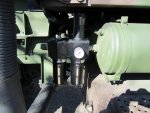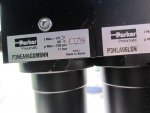Cat has it as a 5P-8942 , I actually use whats known as a double O ring that gives about double the sealing surface, and seem to work the best. The 1s on the last manifold I tore down were wore to the same diameter as the poppet and would fall thru the hole. It was a 1992 rebuilt manifold and very clean inside ( it was the manifold that came out of my m920). but the O rings were worn to a flat side.I truely believe O ring Tech has changed a bit since these were designed, And believe there may be some styles that are better suited.I don't 1 dought what you were seeing at Cat durring that time. I have a semi retired Cat GURU that is near by and has rebuilt a few of these for the military and he has some stories,lol.
I worked this problem several years later than '92.
Your "double o-ring" sounds like what the o-ring suppliers called the "quad-ring". The cross section looks like a 4 leaf clover. If nothing else that should help prevent the piston from tipping in the bore and getting wedged. I recommended the quad-ring but these were military contracts and it took an act of God (actually the DoD) to change the slightest detail of the design.
I had never seen an o-ring design like this one. The transmission engineer told me this was called a "floating piston" design and until the piston was seated it was designed to let some air blow by the piston/o-ring. It could not be a tight seal or the piston/oring would not move. If the air pressure was high enough to move a tight piston, it would wear the snot out of the o-ring because the cylinder is dry.
I looked up floating piston design in the Parker O-ring Handbook. It said flat out that Parker did not recommend using a pneumatic floating piston design because unless everything was perfect, it was a big pile of trouble. From what I saw, Parker knew what they were talking about.
I suspect the problems they were having were related to parts (other than the o-rings ) being out of spec or not meeting the print. The transmission guys were unwilling or unable to correct those problems. The result was I had to prove the o-rings were not the problem. After that, I stopped getting calls and lost track of the situation.
Like I said, the units that finally made it out the door must have been good ones.
Regards
Jim






